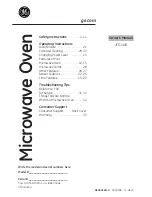
Imp
ort
Ap
plia
nce
s.c
om
THE EASIEST WAY TO SELF-IMPORT APPLIANCES DIRECT FROM EUROPE.
en
Cleaning
40
--------
Notes
■
Slight differences in colour on the front of the
appliance are caused by the use of different
materials, such as glass, plastic and metal.
■
Shadows on the door panels, which look like
streaks, are caused by reflections made by the
interior lighting.
■
Enamel is baked on at very high temperatures.This
can cause some slight colour variation. This is
normal and does not affect operation.
The edges of thin trays cannot be completely
enamelled. As a result, these edges can be rough.
This does not impair the anti-corrosion protection.
Keeping the appliance clean
Always keep the appliance clean and remove dirt
immediately so that stubborn deposits of dirt do not
build up.
:
Warning – Risk of fire!
Loose food remnants, fat and meat juices may catch
fire. Before using the appliance, remove the worst of the
food remnants from the cooking compartment, heating
elements and accessories.
Tips
■
Clean the cooking compartment after each use. This
will ensure that dirt cannot be baked on.
■
Always remove flecks of limescale, grease, starch
and albumin (e.g. egg white) immediately.
■
Use the universal pan for baking very moist cakes.
■
Use suitable ovenware for roasting, e.g. a roasting
dish.
Cleaning the cooking compartment
1.
Pour 0.4 litres of water into the centre of the cooking
compartment floor.
2.
Set the
$
heating function.
3.
Use the temperature controller to set a temperature
of 50 °C.
4.
Switch off the appliance after 18 minutes.
5.
Allow the appliance to cool down.
6.
Clean the cooking compartment with a cloth.
:
Warning – Risk of burns!
The appliance becomes very hot. Never touch the
interior surfaces of the cooking compartment or the
heating elements. Always allow the appliance to cool
down. Keep children at a safe distance.
Appliance interior
Enamelled sur-
faces
Hot soapy water or a vinegar solution:
Clean with a dish cloth and then dry with a soft
cloth.
Soften baked-on food remnants with a damp cloth
and soapy water. Use stainless steel wire wool or
oven cleaner to remove stubborn dirt.
Caution!
Never use oven cleaner in the cooking compart-
ment when it is still warm. This may damage the
enamel. Remove all food remnants from the cook-
ing compartment and the appliance door before
you next heat up the appliance.
Leave the cooking compartment open to dry after
cleaning it.
It is best to use the cleaning function.
"Cleaning function" on page 41
Note:
Food residues can cause white deposits to
form. These are harmless and do not affect how
the appliance works.
Remove using lemon juice if required.
Glass cover for
the interior light-
ing
Hot soapy water:
Clean with a dish cloth and then dry with a soft
cloth.
If the cooking compartment is heavily soiled, use
oven cleaner.
Door panels
Hot soapy water:
Clean with a dish cloth and dry with a soft cloth.
Do not use a glass scraper or a stainless steel
scouring pad.
It is best to clean the door panels along with the
rest of the cooking compartment.
the cooking compartment" on page 40
Door seal
Do not remove.
Hot soapy water:
Clean with a dish cloth.
Do not scour.
Door cover
made from stainless steel:
Use stainless steel cleaner. Follow the manufac-
turers' instructions. Do not use stainless steel
care products.
made from plastic:
Clean using hot soapy water and a dish cloth. Dry
with a soft cloth. Do not use glass cleaner or a
glass scraper.
Remove the door cover for cleaning.
Rails
Hot soapy water:
Soak and clean with a dish cloth or brush.
Pull-out system
Hot soapy water:
Clean with a dish cloth or a brush.
Do not remove the lubricant while the pull-out rails
are pulled out – it is best to clean them when they
are pushed in. Do not clean in the dishwasher.
Accessories
Hot soapy water:
Soak and clean with a dish cloth or brush.
If there are heavy deposits of dirt, use a stainless
steel scouring pad.
















































